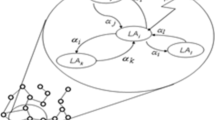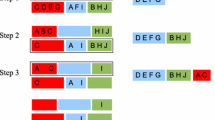Abstract
Vertex coloring problem is a combinatorial optimization problem in graph theory in which a color is assigned to each vertex of graph such that no two adjacent vertices have the same color. In this paper a new hybrid algorithm which is obtained from combination of cellular learning automata (CLA) and memetic algorithm (MA) is proposed for solving the vertex coloring problem. CLA is an effective probabilistic learning model combining cellular automata and learning automaton (LA). Irregular CLA (ICLA) is a generalization of CLA in which the restriction of rectangular grid structure in CLA is removed. The proposed algorithm is based on the irregular open CLA (IOCLA) that is an extension of ICLA in which the evolution of CLA is influenced by both local and global environments. Similar to other IOCLA-based algorithms, in the proposed algorithm, local environment is constituted by neighboring LAs of any cell and the global environment consists of a pool of memes in which each meme corresponds to a certain local search method. Each meme is represented by a set of LAs from which the history of the corresponding local search method can be extracted. To show the superiority of the proposed algorithm over some well-known algorithms, several computer experiments have been conducted. The results show that the proposed algorithm performs better than other methods in terms of running time of algorithm and the required number of colors.




Similar content being viewed by others
Explore related subjects
Discover the latest articles and news from researchers in related subjects, suggested using machine learning.References
Lewis R, Paechter B (2007) Finding feasible timetables using group-based operators. IEEE Trans Evol Comput 11:397–413
Barnier N, Brisset P (2004) Graph coloring for air traffic flow management. Ann Oper Res 130:163–178
Chaitin GJ, Auslander MA, Chandra AK, Cocke J, Hopkins ME, Markstein PW (1981) Register allocation via coloring. Comput Lang 6:47–57
Leighton FT (1979) A graph coloring algorithm for large scheduling problems. J Res Natl Bureau Standards 84:489–506
Karp RM (1972) Reducibility among combinatorial problems. In: Miller RE, Thatcher JW (eds) Complexity of computer computations. Plenum Press, New York, pp 85–103
Narendra KS, Thathachar MAL (1989) Learning automata: an introduction. Prentice-Hall, New York
Thathachar MAL, Sastry PS (2002) Varieties of learning automata: an overview. IEEE Trans Syst Man Cybern Part B Cybern 32:711–722
Caramia M, Dell’Olmo P (2008) Embedding a novel objective function in a two-phased local search for robust vertex coloring. Eur J Oper Res 189:1358–1380
Galinier P, Hertz A, Zufferey N (2008) An adaptive memory algorithm for the k-coloring problem. Discrete Appl Math 156:267–279
Lourenço HR, Martin O, Stutzle T, Glover F, Kochenberger G (2002) Iterated local search. In: Handbook of Metaheuristics, pp 321–353
Caramia M, Dell’Olmo P, Italiano GF (2006) CHECKCOL: improved local search for graph coloring. J Discrete Algorit 4:277–298
Chiarandini M, Dumitrescu I, Stützle T (2007) Stochastic local search algorithms for the graph colouring problem. In: Handbook of approximation algorithms and metaheuristics, pp 1–63
Akbari Torkestani J, Meybodi MR (2011) A cellular learning automata-based algorithm for solving the vertex coloring problem. Expert Syst Appl 38:9237–9247
Lawler EL (1976) A note on the complexity of the chromatic number problem. Inf Process Lett 5:66–67
Jesper Makholm B (2004) Exact algorithms for graph colouring and exact satisfiability. Oper Res Lett 32:547–556
Beigel R, Eppstein D (2005) 3-coloring in time O (n1. 3289). J Algorit 54:168–204
Byskov JM (2004) Enumerating maximal independent sets with applications to graph colouring. Oper Res Lett 32:547–556
Rezapoor M, Meybodi MR (2013) LA-MA: a new memetic model based on learning automata. In: Proceeding of 18th national conference of Computer Society of Iran, Tehran, Iran, pp 1–16
Hertz A, de Werra D (1987) Using tabu search techniques for graph coloring. Computing 39:345–351
Fleurent C, Ferland JA (1996) Genetic and hybrid algorithms for graph coloring. Ann Oper Res 63:437–461
el Dorne R, Hao J (1998) A new genetic local search algorithm for graph coloring
Galinier P, Hao J-K (1999) Hybrid evolutionary algorithms for graph coloring. J Combin Optim 3:379–397
Oommen B, Hansen E (1984) The asymptotic optimality of discretized linear reward-inaction learning automata. IEEE Trans Syst Man Cybernet 14:542–545
Johnoommen B (1986) Absorbing and ergodic discretized two-action learning automata. IEEE Trans Syst Man Cybernet 16:282–293
Akbari Torkestani J, Meybodi MR (2010) Learning automata-based algorithms for finding minimum weakly connected dominating set in stochastic graphs. Int J Uncertain Fuzziness Knowl Based Syst 18:721–758
Akbari J (2012) An adaptive focused web crawling algorithm based on learning automata. Appl Intell 37:586–601
Akbari Torkestani J, Meybodi MR (2010) An efficient cluster-based CDMA/TDMA scheme for wireless mobile ad-hoc networks: a learning automata approach. J Netw Comput Appl 33:477–490
Akbari Torkestani J, Meybodi MR (2010) Mobility-based multicast routing algorithm for wireless mobile Ad-hoc networks: a learning automata approach. Comput Commun 33:721–735
Akbari Torkestani J, Meybodi MR (2010) An intelligent backbone formation algorithm for wireless ad hoc networks based on distributed learning automata. Comput Netw 54:826–843
Jahanshahi M, Dehghan M, Meybodi M (2013) LAMR: learning automata based multicast routing protocol for multi-channel multi-radio wireless mesh networks. Appl Intell 38:58–77
Meybodi MR (1983) Learning automata and its application to priority assignment in a queueing system with unknown characteristics. Ph.D. thesis, Departement of Electrical Engineering and Computer Science. University of Oklahoma, Norman
Tsetlin ML (1973) Automaton theory and modeling of biological systems, vol 102. Academic Press, New York
Hashim A, Amir S, Mars P (1986) Application of learning automata to data compression. In: Adaptive and learning systems, pp 229–234
Manjunath B, Chellappa R (1988) Stochastic learning networks for texture segmentation. In: Twenty-second asilomar conference on signals, systems and computers, pp 511–516
Oommen BJ, Hansen E (1987) List organizing strategies using stochastic move-to-front and stochastic move-to-rear operations. SIAM J Comput 16:705–716
Oommen BJ, Ma DCY (1988) Deterministic learning automata solutions to the equipartitioning problem. IEEE Trans Comput 37:2–13
Frost GP (1998) Stochastic optimisation of vehicle suspension control systems via learning automata. Ph.D. Thesis, Department of Aeronautical and Automotive Engineering. Loughborough University, Loughborough
Howell M, Frost G, Gordon T, Wu Q (1997) Continuous action reinforcement learning applied to vehicle suspension control. Mechatronics 7:263–276
Unsal C, Kachroo P, Bay JS (1999) Multiple stochastic learning automata for vehicle path control in an automated highway system. IEEE Trans Syst Man Cybernet Part A Syst Humans 29:120–128
Beigy H, Meybodi MR (2009) A learning automata-based algorithm for determination of the number of hidden units for three-layer neural networks. Int J Syst Sci 40:101–118
Meybodi MR, Beigy H (2001) Neural network engineering using learning automata: determining of desired size of three layer feed forward neural networks. J Faculty Eng 34:1–26
Oommen BJ, Croix DS (1997) String taxonomy using learning automata. IEEE Trans Syst Man Cybern Part B Cybern 27:354–365
Barto AG, Jordan MI (1987) Gradient following without back-propagation in layered networks. In: 1st International Conference Neural Nets, San Diego
Thathachar M, Phansalkar VV (1995) Learning the global maximum with parameterized learning automata. IEEE Trans Neural Netw 6:398–406
Galinier P, Hertz A (2006) A survey of local search methods for graph coloring. Comput Oper Res 33:2547–2562
Rezapoor M, Meybodi MR (2014) A new criteria for creating balance between local and global search in memetic algorithms. Iranian J Electr Comput Eng (IJECE) 12:31–37
Johnson DS, Aragon CR, McGeoch LA, Schevon C (1991) Optimization by simulated annealing: an experimental evaluation; part II, graph coloring and number partitioning. Oper Res 39:378–406
Author information
Authors and Affiliations
Corresponding author
Appendix
Appendix
The notations used in the proposed algorithm are listed in Table 9.
Rights and permissions
About this article
Cite this article
Rezapoor Mirsaleh, M., Meybodi, M.R. A new memetic algorithm based on cellular learning automata for solving the vertex coloring problem. Memetic Comp. 8, 211–222 (2016). https://doi.org/10.1007/s12293-016-0183-4
Received:
Accepted:
Published:
Issue Date:
DOI: https://doi.org/10.1007/s12293-016-0183-4




